
Scholars theorizing the connections among nationalism, religion, and violence have presented a wide range of perspectives. Atalia Omer and Jason A. Springs’s co-authored reference handbook on religious nationalism provides an overview of the subject with attention to critical analyses of secularism, modernity, and orientalism. Whereas Benedict Anderson’s influential work on the origins of nationalism—which defines the “nation” as an “imagined community” that evokes a sense of collectivity, communion, and common history across a people group—argues that nationalism developed in the eighteenth and nineteenth centuries, Omer and Springs contend that “nationalism is not strictly a modern phenomenon” (26). They also argue that religious forms of nationalism are not inherently more volatile or “irrational” than presumably “secular” forms of nationalism, and further, that “secular” and “religious” forms of nationalism cannot be clearly distinguished from or contrasted with each other. Omer and Springs introduce the term “ethnoreligious nationalism” to describe the need for examining nationalism, religion, and ethnicity together, particularly in cases in which “religious identity markers blur or merge with ethnic identity markers” (15) and the language of authenticity and purity is mobilized in support of violence. This module takes Omer and Springs’ definition of religious nationalism as a starting point for an investigation across geographies, disciplines, and conceptual terrains that have been explored in blogs on the CM site.
Omer and Springs’s critical approach to “secularism” resonates with the influential works of anthropologist Talal Asad, which highlight the dynamic and ongoing construction of “religion” and the “secular” as categories and critique the use of the “secular” as a designation for that which is considered rational and acceptable in public spheres. Asad challenges the ways that the “secular” is often imagined as a modern successor to “religion,” arguing in particular against the idea that nationalism should be understood as secularized religion. Further complicating the presumed “religious”/“secular” divide, Asad writes that secular states should be understood in terms of their efforts to regulate—not eliminate—violence and intolerance directed against “religious minorities.” Similarly, historians of religion such as Tisa Wenger have described the ways that discourses of religious freedom, pluralism, and tolerance—particularly in the context of the ostensibly “secular” U.S. empire—have been mobilized by the dominant White Christian population to naturalize and reinforce White Christian norms, which in Omer and Springs’s terminology may be understood as a form of ethnoreligious nationalism. Wenger notes, however, that discourses of religious freedom have also been reappropriated by minoritized and colonized groups to challenge racial and religious forms of violence and exclusion. These studies question assumptions of particular, bounded, stable “religions”; complicate the division between “secular” and “religious”; and discuss the divergent political uses of presumably tolerant approaches to religion in “secular” national contexts.
Informed by these critical approaches, historians, anthropologists, sociologists, political scientists, and religious studies scholars have offered focused analyses of diverse manifestations of ethnoreligious nationalism. These include Hindu nationalism in the Indian subcontinent, Arab and Muslim nationalisms, Zionism and the reshaping of Jewish memory in the construction of an Israeli national tradition, Sinhalese Buddhist nationalism, and U.S.-based White Christian nationalism. Additionally, scholarship on religion, conflict, and peacebuilding has engaged analyses of religious nationalism in order to offer a nuanced theorization of the relationship between religion and violence, while simultaneously exploring the constructive roles that religion can play in political life, conflict transformation, and peacebuilding.
This educational module introduces teachers, students, and practitioners to three major themes pertaining to religion, nationalism, and conflict: the deployment of narratives of victimization to support a dominant ethnoreligious group’s maintenance of power within a particular context, the mobilization of various Islamophobic discourses across geographies, and proposals for interreligious conflict transformation and peacebuilding. The examination of such themes provides an assessment of how religious nationalisms shape global politics and allows readers to examine the convergences and divergences among various forms of religious nationalism in diverse contexts. This module also highlights constructive postcolonial/decolonial efforts towards religious pluralism and peacebuilding.
Theme 1: Religious Nationalism and Narratives of Victimization
These pieces explore the role that narratives of victimization serve in various manifestations of religious nationalism. Philip Gorski’s post identifies victimization narratives as one key element of religious nationalism, particularly in “western” contexts, but which are also applicable elsewhere. Jason A. Springs’s post describes narratives of persecution and marginalization that inform White evangelical Christian ethnoreligious nationalism in the United States. Raz Segal discusses the weaponization of discourses of antisemitism to silence legitimate critiques of apartheid in Israel/Palestine. Ather Zia’s post reveals how Hindu nationalists construct Muslims as threatening “invaders” in order to maintain a position of dominance in the Indian subcontinent. Lastly, Gladys Ganiel’s piece addresses competing narratives of victimization between Protestant-Unionist-Loyalists and Catholic-Nationalist-Republicans in Northern Ireland. Together, these pieces offer diverse examples of the ways that religious nationalisms from different contexts mobilize narratives of victimization in order to construct a threatening ethnoreligious “other” and to justify violence against this “other.” Importantly, claims of victimization, marginalization, and oppression are not always false. These pieces, however, point to the ways that a community that in fact comprises a dominant ethno-cultural majority might employ narratives of victimization to justify their own moral superiority and maintenance of power and domination within a particular context—a phenomenon that Gorski’s post identifies as a key element of religious nationalism.
Religious Nationalism and Right Wing Populism: Trumpism and Beyond

This post by Philip Gorski examines the nature of right-wing populism and its affinity with religious nationalism. Although Gorski begins by considering White evangelical Christian nationalism and Trump’s ascendancy in the American right, he notes that connections between religious conservatism and right-wing populism go beyond and before Trumpism in the United States (with Hindu nationalism in the Indian subcontinent being an example from another context). While nationalism was once theorized as a secular, modern version of religion, Gorski argues that religious nationalism is a distinctive variant of modern nationalism—a perspective that contrasts with that presented in Omer and Springs’s reference handbook—and that connections between religion and nationalism also existed before modernity. He identifies blood tropes, apocalyptic narratives, victimization narratives, and messianic expectations as four key elements of “western” versions of religious nationalism, which are historically rooted in Jewish and Christian scriptures, but notes that these elements are also commonly found in “non-western” Hindu, Islamic, and Buddhist religious nationalisms. Gorski then describes right-wing populism as a narrative in which a “pure” people are betrayed by a “corrupt” elite who has allied with an undeserving other. Because of this narrative of corruption, they place hope in a messianic leader who “promises to restore the people to its birthright.” Significant overlaps between this populist victimization narrative and the key elements of religious nationalism—which are evident, for instance, in the portrayal of the dominant ethno-cultural majority as a supposedly morally pure yet persecuted religious minority—may explain the attraction of religious nationalists to right-wing populist movements and of right-wing populists to religious nationalism.
While Gorski notes that further comparative work is needed to contend with other forms of religious nationalism, he writes that much of this framework could apply in “non-western” contexts shaped by other religious discourses. His discussion of narratives of victimization can be applied to White evangelical Christian nationalism, as Jason A. Springs’s post details further, but also to other examples of religious nationalism that are discussed throughout this educational module. While Gorski’s emphasis on the distinctness of religious nationalism—implying an acceptance of the separability of “religious” and “secular” forms of nationalism—might be critiqued by other schools of thought regarding the relationship between nationalism, religion, and violence, his framework provides a useful analysis of the connections between particular religious discourses and the key elements of populist, nationalist narratives.
QAnon, Conspiracy, and White Evangelical Apocalypse

This post by Jason A. Springs examines the role of apocalypticism and messianism in White Christian evangelical nationalism. While elaborating on his concept of “zombie nationalism”, Springs writes that the continual reoccurrence and reanimation of this form of religious nationalism is driven by “U.S. White evangelical Christians conceptualizing themselves as an increasingly marginalized remnant in a society that (putatively) originally did, and (allegedly) should still, reflect their central identity and values” and imagining themselves as a “perennially marginalized—and progressively more endangered—victims of an aggressively anti-Christian ‘secular’ society.” This post contends that the tropes employed by QAnon—particularly its assertions that the Democratic party is controlled by an anti-Christian elite, that Trump is a messianic figure whose actions have apocalyptic significance, and that America’s “true” Christian identity must be retrieved—have precedents in the White evangelical movement in the United States. Springs argues that “QAnon conspiracy ideology symbiotically feeds upon populist White evangelical impulses toward apocalypticism and messianism” and fuses them with Republican political ideology.
Springs’s attention to the recurrent pattern of White evangelical Christian nationalists conceptualizing themselves as a “victimized-yet-faithful and long-suffering” chosen people elucidates the role that narratives of victimization serve in the context of U.S.-based White Christian nationalism. This post and others in Springs’s series on “zombie nationalism,” such as “Race, Ressentiment, and Nihilism in White Evangelical Christian Nationalism,” show how narratives of White Christian victimization—particularly in relation to anxieties around White majority status diminishing, America’s “Christian values” being lost, and heteronormative sexual politics being challenged—are mobilized as “a covert means of conjuring and asserting power” and maintaining a position of ethno-cultural dominance.
Israel Apartheid and Its Apologists

In this post, Raz Segal uses the 2022 confirmation hearing of Dr. Deborah Lipstadt for the role of Special Envoy to Monitor and Combat Antisemitism as a case study in how apologists of the Israeli state reframe critiques of Israel’s policies as antisemitic attacks. Segal, who studies the Holocaust, Jewish history, and antisemitism, argues that those who defend Israel’s apartheid against Palestinians “distort legitimate criticism of a state and present it, only in the case of Israel [and not in the case of criticism of Russia’s war in Ukraine, for example], as an attack against a people.” In response, Segal provides evidence to support Amnesty International’s claim that Israel has created and maintained a system of apartheid against Palestinians, and to show that critiques of Israeli state violence are legitimate. He writes that the weaponization of discourses of antisemitism to silence criticism of the Israeli state “abus[es] the historical struggle of a vulnerable people, Jews, under attack by powerful states to blur the attack of a state, Israel, against a vulnerable people, Palestinians.” Segal argues that such conflations lead not only to a false picture of the reality faced by Palestinians, but also risk reinforcing the segregationist logic of antisemitism that the apologists claim to combat—that is, the idea that Jewish people belong in Israel and only in Israel.
In this context, the use of narratives of victimization—specifically, the weaponization of the charge of antisemitism in discussions of Palestine/Israel—serves to conceal realities of settler-colonialism and apartheid and to actually reinforce antisemitic logics. For more information about this topic, see posts by Atalia Omer and Moshe Behar that critique how the International Holocaust Remembrance Alliance (IHRA) has weaponized discourses of antisemitism in ways that stifle legitimate criticisms of the state of Israel and cause important manifestations of antisemitism to go overlooked. Also see Brian Klug’s posts on Europe’s “Jewish Question” and the need for its “unasking.” Klug argues that shielding Israel and Zionism from critique positions Jewish people as “the valorized Other of Europe” (thus reinforcing Jewish otherness and failing to treat Jewish people as normal human beings). He also asserts that critiques of Israel and Zionism must contend with histories of antisemitism in Europe rather than “fold[ing] Zionism completely, without remainder, into the history of European hegemony over the Global South, as if this were the whole story.” Elizabeth Shakman Hurd’s and Raef Zreik’s contributions to the book symposium on When Politics are Sacralized: Comparative Perspectives on Religious Claims and Nationalism also address Zionism and Palestine/Israel.
The Hindu Rashtra Comes of Age
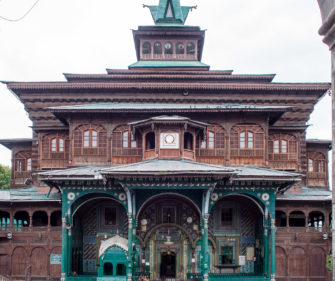
This post by Ather Zia details how the 2019 revocation of Article 370—which had previously acknowledged the special status of Indian-administrated Kashmir and maintained the autonomy of the region in formulating laws—serves the Hindu nationalist agenda, which envisions a unified social fabric built on a conception of “Hinduness.” Zia notes that the ideology of Hindu indigeneity in the Indian subcontinent “casts Muslims living in India as invaders and foreigners”; thus, “Kashmiri Muslims are doubly marked as the demonized other: first as Muslims, and second as Kashmiris who are longstanding dissidents committed to the fight for a UN [United Nations]-mandated plebiscite, democratic sovereignty, and freedom from India.”
The post also provides a brief overview of Kashmir’s recent history and religious demographics and explores how past events and recurrent narratives of victimization shape the current conflict dynamics. Zia covers the 1846 Amritsar Treaty in which the British Empire sold the land and people of Kashmir to a Hindu warlord, the Kashmiri movement for sovereignty and independence that first rose in prominence around 1931, the UN-arbitrated bifurcation of Kashmir into Indian- and Pakistan-administered territories around 1947–1948, and the drafting and later revocation of Article 370. Zia writes that the RSS (Rashtriya Swayam Sevak Sangh)—a Hindu supremacist paramilitary organization—had rejected the special autonomous status of historically-Muslim-majority Kashmir because they viewed it “as an appeasement of Muslims and a threat to Indian unity.” Zia’s account shows how narratives of victimization (or anticipated/feared victimization) have enabled Hindu nationalists in the subcontinent to construct Muslims as threatening others, to justify Indian settler colonialism, and to support the passage of legislation that discriminates against Muslims.
Northern Ireland’s Troubled Relationship with Religion: Structures, Practices, and Definitions

In this post, which is part of a book symposium on Nadim N. Rouhana and Nadera Shalhoub-Kervorkian’s edited volume When Politics are Sacralized: Comparative Perspectives on Religious Claims and Nationalism, Gladys Ganiel analyzes examples of religious nationalism in diverse contexts and shows how states have invoked religious claims in order to justify assertions of sovereignty and legitimize violence. (For a more detailed summary of the book, refer to this introduction to the book symposium.) Ganiel’s post focuses on Northern Ireland’s Troubles and points out that, although some scholarship on this issue downplays the role of colonialism and religion, When Politics are Sacralized helpfully foregrounds settler colonialism (particularly the role of the British state as a colonial power that informs Protestant-Unionist-Loyalist versus Catholic-Nationalist-Republican conflicts) and religious claims.
Ganiel’s post recognizes that conflicting narratives of victimization shape interpretations of the conflict in Northern Ireland: “Loyalists [Protestant, Unionist] identify with an Israel that they perceive as under attack by terrorists, while Republicans [Catholic, Nationalist] identify with Palestinians whose land has been occupied.” Her contribution valuably explores the complexities of victimization narratives that are mobilized on both sides of a conflict, while emphasizing that such narratives must be evaluated through an awareness of historical power dynamics. Although one must acknowledge the migration of some Protestants to Northern Ireland as a result of their experience of structural violence in Catholic-dominated Republic of Ireland, it is also true that Protestant Unionist elites have constructed colonial political structures in Northern Ireland since its creation in 1921. (For more on the latter, see Cathal McManus’s discussion of the Orange Order.) Like the Hindu nationalists explored in the previous post by Ather Zia, Unionists in Northern Ireland also fear future victimization and have drawn on that narrative to sustain their position. Here, their fear is that a unification with the Republic of Ireland will result in their oppression as a Protestant minority in a Catholic-majority state. For more information on the complexities of colonialism and decolonial thought in the context of Northern Ireland and the Republic of Ireland, see this post by Maxwell Woods, which shows that decolonization alone is not sufficient for guaranteeing justice.
Theme 2: Religious Nationalism and Islamophobia
These pieces examine the ways that longstanding, global discourses of Islamophobia and more recent deployments of language of “terrorism” have functioned to support religious nationalisms in various contexts. Jason A. Springs’s post points to the subtle manifestations of Islamophobic European nationalisms in presumably “secular” laws that advance anti-Muslim discrimination. Similarly, Uzma Jamil critiques the ways that the idealization of “secularism” within White Quebecois nationalism contributes to both a systemic context of Islamophobia and a determined refusal to acknowledge this Islamophobia. Julia Kowalski shows how Muslim women protesters in India have challenged the stereotypes about Islam and gender that Hindu nationalists have promoted. Rachel Harris discusses the Chinese government’s campaign of cultural cleansing against the Turkic Muslims of the Xinjiang Uyghur Autonomous Region of China, which has drawn upon the United States’ post-9/11 rhetoric of religious extremism and terrorism as well as Islamophobic discourses from other sources. Perin Gürel also discusses violence against Uyghurs, but focuses on complicating the idea of a unified “Muslim world” by examining the ways that different Muslim-majority countries have responded to the oppression of Uyghur Muslim communities in China. Together, these posts address multiple discourses and manifestations of Islamophobia—including and beyond the U.S.-led “war on terror”—and the ways that images of Islam being incompatible with both secular modernity and notions of cultural/national authenticity have informed religious nationalisms in different contexts.
Tentacles of the Leviathan? Nationalism, Islamophobia, and the Insufficiency-yet-Indispensability of Human Rights for Religious Freedom in Contemporary Europe
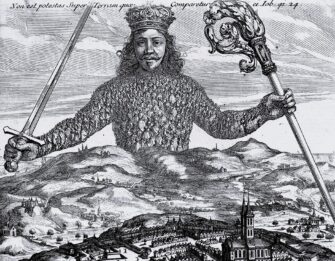
In this post, which is an abbreviated overview of an article that was published in the Journal of the American Academy of Religion, Jason A. Springs observes how many rulings by the European Court of Human Rights point to the idea that “the expanding presence of Islam throughout Europe presents a pronounced challenge to Western conceptions of secular law and human rights.” He writes that European nationalisms identifying and scapegoating an inassimilable Muslim “other” seem to underlie this idea. Noting that the consideration of only the most extreme or radical manifestations of Islamophobic European nationalisms can obscure more surreptitious and pervasive varieties, Springs attends to subtle European ethnoreligious nationalisms that occur as modes of anti-Muslim “exclusion, inequality, and humiliation.”
Springs warns that human rights discourses have been mobilized in Islamophobic European nationalist ways. Turning to recent French headscarf bans as a case study, he shows that even some avowedly secularist state laws represent subtle forms of ethnoreligious nationalism that advance anti-Muslim discrimination. At the same time, Springs presents international human rights norms and institutions as insufficient yet indispensable sites of potential for guarding against religious nationalism and protecting religious freedom in contemporary European contexts. He argues for a corrective approach to human rights discourse which would contend with the political and cultural power dynamics “that inevitably influence adjudication of human rights cases,” and in response, intentionally incorporate “analytical tools that guard against [human rights discourse’s] unjust applications.”
Islamophobia and Epistemological Ignorance
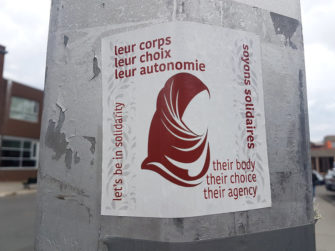
In this post, Uzma Jamil critiques the systemic context of Islamophobia reinforced by Quebec’s idealization of “secularism,” focusing particularly on the tendency of White politicians and citizens to deny the role of Quebec’s secularist Bill 21 in creating conditions for Islamophobic violence elsewhere in Canada. Such denials indicate a “refusal to know and to see Islamophobia,” which Jamil argues “is ultimately a refusal to accept the political claim by Muslims to be treated as equal citizens” and “a refusal to see how Islamophobia is sustained through its connection to Whiteness in Quebec.”
Jamil explains that Bill 21, a 2019 Quebec law which prohibits people who wear religious symbols from working in the public sector or engaging with public services, “disproportionately excludes Muslim women who wear hijabs.” She discusses the law’s rootedness in key aspects of “modern” Quebecois nationalism—which since the 1960s–70s Quiet Revolution that resulted in the Catholic Church’s removal from its previous prominent role in the public sphere—has been centered around secularism, gender equality, and the French language. Muslim women who wear hijabs and niqabs are frequently represented as threats to these nationalist ideals of secularism and gender equality. As Jamil argues, the maintenance of Quebec’s nationalist “secularism” rests upon “the erasure of Muslim religiosity from public space”—an erasure which ultimately serves to legitimize acts of Islamophobic violence.
Jamil writes that victimization narratives that focus exclusively on French Quebec’s minority position in relation to English Canada also inform denials of Bill 21’s role in reinforcing Islamophobia in other parts of Canada. Such victimization narratives are incomplete and ignore the fact that both are White settler societies which hold a position of dominance in relation to racialized, non-White minorities. Refusals to see Islamophobia and White supremacy indicate an “epistemology of ignorance”: anti-racist philosopher Charles Mills’s term for the ways that an intentional failure to see Whiteness is “a necessary requirement for the structure of White supremacy to exist and to endure.” Like the Islamophobic European nationalism identified by Springs, White Quebecois nationalism is a form of ethnoreligious nationalism that conceals itself through secularist language and various “refusals to see” Islamophobia and White supremacy. Against this epistemology of ignorance, expressions of Muslim political consciousness and agency—seen in rising efforts to name and combat Islamophobia—have the potential to reshape conversations around Islamophobia, Whiteness, and ethnoreligious nationalism in Quebec.
Remaking Indian Secularism: The Fearless Grannies (Dadis) of Shaheen Bagh
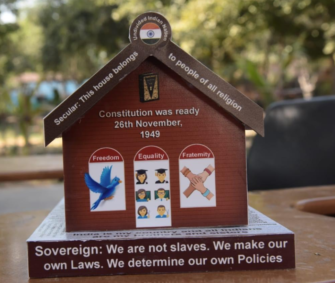
In this post, Julia Kowalski discusses protests that took place in the Shaheen Bagh neighborhood of Delhi from 2019–2020 in resistance to the combined effects of the Citizenship Amendment Act (CAA) and the National Register of Citizens (NRC). She writes that these protests—attended mostly by middle-class, middle-aged-or-older women wearing hijab—represented acts of subversion against stereotypes about Islam and gender that the ruling Bharatya Janata Party in India has deployed to advance Islamophobic legislation. (For more information about the CAA and NRC as discriminatory against Muslims, see this post by Susan Ostermann.) Kowalski argues that Muslim women protestors innovatively mobilized representations of female kinship (including by referring to older protesters as dabaang dadis—“fearless grannies”) and home while promoting the vision of a secular, inclusive democracy and of religiously pluralistic national belonging in India.
When contextualizing stereotypes about Islam and gender in India, Kowalski notes that “[s]ince the late twentieth century, the Hindu right has targeted Muslim family laws, and their supposed ill-treatment of Muslim women, to argue for universal (read: Hindu) family and inheritance laws.” She connects these moves to longer, global histories of Islamophobic discourses that have promulgated notions of “oppressed Muslim women” in order to condemn Islam as “uncivilized” and justify Western colonial and imperial intervention in majority-Muslim contexts. In India, the Hindu right has co-opted critiques of gender inequality in order to advance these notions of “oppressed Muslim women” and “undermin[e] the status of Muslims in India more broadly.” Against these Islamophobic discourses, Kowalski’s post shows how Muslim women protesters in the Shaheen Bagh neighborhood have contested right-wing Hindu nationalism, countered narratives of Muslim non-belonging in India, and subverted sexist and Islamophobic representations of Muslim women.
(Note: a different exposition of this post appears within the “Politics of the Gender, Sexuality, and Religion Nexus” module, since Kowalski’s analysis focuses on the intersections among Islamophobia, gender, colonialism, and religious nationalism.)
Uyghur Religious Heritage under China’s “Anti-Religious Extremism” Campaigns

This post by Rachel Harris discusses the Chinese government’s escalating “counterterrorism” in the Xinjiang Uyghur Autonomous Region of China—or, more accurately, cultural cleansing driven by Chinese President Xi Jinping’s campaign to control the region and its natural resources. Harris explains that the strategic management and positioning of cultural heritage “serves as a resource for political legitimacy and soft power and is used as an asset to boost local economic development”—for instance, by driving tourism and Han Chinese settlement in the Uyghur region. Despite the listing of sites of Uyghur religious heritage on local and international protected heritage lists, Harris points to “the large-scale destruction of sacred sites, prohibitions on Uyghur language and literature, and disruption of Uyghur communities since 2017” as evidence that “the biggest threats to Uyghur heritage and culture are the policies of the Chinese government itself.”
Harris writes that by the 1990s, “strike hard” campaigns led by Xinjiang authorities began to repress religious practices central to Uyghur culture, such as by designating pilgrimages to shrines as “illegal religious activities.” Beginning in the 2000s, the Chinese government drew from global Islamophobic discourses and from the rhetoric of religious extremism and terrorism deployed within the U.S.’s “Global War on Terror” in order to re-categorize such Uyghur religious practices as acts of “religious extremism” and “to justify its actions against the Uyghurs and other Turkic Muslim minorities: actions which were increasingly taking the form of cultural cleansing.” The anti-religious extremism campaign in Xinjiang has involved the demolition of thousands of mosques, shrines, and cemeteries important to Turkic Muslim Uyghurs’ religious heritage, accompanied by heavy securitization, mass incarceration, and attacks on Uyghur language in the region. Harris contextualizes these repressive acts as “a part of the national campaign to ‘Sinicize’ religion” in China and warns that the systematic destruction of a people’s cultural and religious heritage frequently functions as a precursor to genocide.
Whose People? The Oppression of Uyghurs and the Idea of the Muslim World
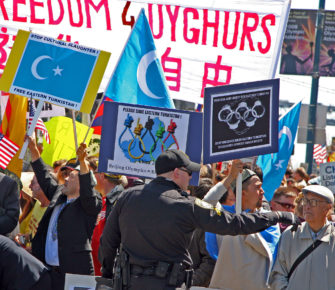
This post by Perin Gürel challenges monolithic ideas of Islam and the “Muslim world” that dominate Western discourse on Uyghur issues, focusing on the ways that Muslim-majority countries are often expected “to respond to the oppression of Muslims across state boundaries [and particularly to condemn the oppression of Uyghurs] in a way that is not expected from Christian-majority countries.” Gürel emphasizes the heterogeneous policies within Muslim-majority countries and the existence of disunity among them in order to push for more nuanced and contextually informed understandings of how countries such as Saudi Arabia, Iran, and Türkiye respond differently to the treatment of Uyghur communities in China. She notes that although the Turkish government did issue a statement condemning the Chinese government’s violation of the human rights of Uyghur Turks and other Uyghur Muslim communities, international politics and economic relations shape governments’ decisions. She contends that those who uphold the idea of a presumably unified “Muslim world” must recognize that “the failure to condemn international human rights abuse despite cultural, linguistic, and religious ties with its victims is not unusual.”
Theme 3: Constructive Proposals for Religious Pluralism and Interreligious Peacebuilding
These posts introduce frameworks for envisioning religious pluralism and justice-oriented peacebuilding in contexts that have been impacted by violence and religious nationalism(s). Abir Bazaz discusses ideas of religious tolerance, respect, and freedom in Kashmiri history and literary culture in order to propose certain visions of Kashmiri religious pluralism as productive alternatives to Indian secularism in South Asian contexts. Bashir Bashir proposes egalitarian binationalism as a constructive ethical principle that can be applied to Israel/Palestine. Kwok Pui Lan shows how postcolonial scholarship can dismantle colonial myths that impede discussions within the field of religion and peacebuilding and offer constructive criticisms of the field. Jenna Streich, although not explicitly focused on religious nationalism, offers reflections on the ways that Catholic schools might combat religious perpetrations of violence, move away from a conversion model and towards one which honors students’ diverse religious and cultural traditions, and work towards justice-oriented peacebuilding in their communities. Her post demonstrates the on-the-ground educational work required to resist exclusionary religious nationalisms. Through cultural/literary, political/governmental, religious/social, and educational registers, these four posts offer distinct frameworks for responding to religious nationalism, addressing violence and conflict, and working towards religious pluralism and peacebuilding.
What is so Special about Kashmir’s Special Status?

In this post, Abir Bazaz traces the deployment of the idea of Kashmir as a “special place” over time, including in the popular movement for Kashmiri sovereignty (joined by Kashmiri Muslims and Hindus and supported by Indian nationalists) against Dogra rule in the 1920s–40s, and in the recognition of the region’s “special status” through Article 370 of the Indian Constitution. The provisions of Article 370 were slowly eroded, however, as Hindu nationalists accused them of representing “nothing other than yet another shameful capitulation by the ruling Indian National Congress Party to Muslims,” and in 2019, Article 370 was revoked entirely. (For more information about Article 370 and Kashmir’s recent history, see this post by Ather Zia discussed earlier in this module.) Bazaz warns that “cancelling Kashmiri autonomy … could return Kashmir to being narrowly imagined as a site of sectarian Hindu-Muslim conflict.”
Referring to the mobilization of religion and culture in the political claims of India and Pakistan on Kashmir, Bazaz writes that “even though the Hindu and Muslim religious cultures in India and Pakistan offer us fantasies of Kashmir as either a sacred Hindu space or a lost Muslim paradise, the actual Kashmiri Hindu and Muslim religious culture affirms Kashmir as a heterodox and plural spiritual space.” He turns to fourteenth- and fifteenth-century examples of Saiva-bhakti-Sufi-tantric poetry in Kashmir to show how ideas of religious tolerance and caste equality have a long history within Kashmiri literary culture. Such visions of Kashmiri religious pluralism are already “affirmed by many Kashmiri Hindus and Muslims” and, if attended to more deeply in the present, might open up new ways of thinking about democracy, freedom, and interreligious respect in South Asia. This unique vision of religious pluralism is “[w]hat is, and remains, special about Kashmir,” and offers a justice- and peace-centered alternative vision for the future of the region in contrast to the exclusionary chauvinist nationalism of the Modi government in India.
Interrogating Modernity and Egalitarian Binationalism in Palestine/Israel
 This post by Bashir Bashir, co-editor of The Arab and Jewish Questions alongside Leila Farsakh, introduces a symposium on the book by describing the wider research projects that gave rise to it. (This post by Farsakh, which co-introduces the book symposium, focuses more on describing the book’s thesis and contents.) Bashir provides an overview of the conflict between Zionism and Palestinian nationalism, alternatives to partition, memories of the Holocaust and the Nakba, and the connections between antisemitism and Islamophobia in Europe that have informed these prior projects and publications.
This post by Bashir Bashir, co-editor of The Arab and Jewish Questions alongside Leila Farsakh, introduces a symposium on the book by describing the wider research projects that gave rise to it. (This post by Farsakh, which co-introduces the book symposium, focuses more on describing the book’s thesis and contents.) Bashir provides an overview of the conflict between Zionism and Palestinian nationalism, alternatives to partition, memories of the Holocaust and the Nakba, and the connections between antisemitism and Islamophobia in Europe that have informed these prior projects and publications.
Based on his participation in research on the conceptual and historical links among the “question of Israel/Palestine,” the “Arab-Muslim question,” and the “Jewish question”—and among the dynamics of colonialism, Orientalism, Islamophobia, and antisemitism—Bashir proposes egalitarian binationalism as an ethical frame for challenging colonialism, promoting historical reconciliation, and dismantling Jewish Israeli supremacy in Palestine/Israel. He defines egalitarian binationalism as “a principle that recognizes and promotes the existence of two national groups with equal rights to self-determination … while insisting that this right ought to not be realized in the form of an exclusive ethnic state.” Bashir writes that some analyses of settler colonialism—though importantly drawing attention to power asymmetries between Israeli and Palestinian peoples and to the centrality of land in Palestine/Israel conflicts—are “underdetermined regarding what would be the ultimate outcome of decolonization.” As an alternative theoretical framework, Bashir argues that the principle of egalitarian binationalism “offers rich resources for a decolonizing project in Israel/Palestine that seeks to establish a polity based on the principles of justice and equality, coming to terms with historical injustices, and imagining alternative pasts, presents, and futures based on Palestinian-Israeli relationships.”
For more information about the “Jewish Question,” histories of antisemitism in Europe, and political Zionism, see Brian Klug’s post “Why is the Jewish Question Different from All Similar Questions?” Klug discusses the “Jewish Question” as a European question about the Jewish people, who (in one reading of this question) were positioned as Europe’s antithesis: Europe defined itself first as Christian (as opposed to “Jewish”) and later as a bastion of post-Enlightenment universalism (as opposed to Jewish “particularism”). Additionally, other contributions to the book symposium on The Arab and Jewish Questions contend with European colonialism, histories of antisemitism and Islamophobia, and the relationships among Europe’s “Jewish” and “Arab-Muslim” questions.
Religion and Peacebuilding: A Postcolonial Perspective

In this post, Kwok Pui Lan begins by challenging three dominant myths that are rooted in European and Euro-American colonialism and that tend to impede discussions on religion and peacebuilding: Samuel Huntington’s “clash of civilizations” myth that explains wars and conflicts in terms of clashes between homogeneous, bounded, religiously based civilizations; the secularist myth which views religion as irrational, incompatible with modernity, and an obstacle to conflict resolution; and the Islamophobic myth that sees some religions (like Christianity) as inherently peaceful and other religions (especially Islam) as inherently violent—a myth that, as posts included in the previous theme have shown, has informed Islamophobic forms of religious nationalism. She shows how postcolonial criticism helps debunk these myths and also challenges the legacies of racist and colonialist dynamics that have shaped the field of religious studies.
Kwok Pui Lan then presents the ways that constructive criticism from postcolonial studies might help the emerging field of religion and peacebuilding—which “focuses on the themes of interreligious dialogue, the retrieval of religious resources for peacebuilding in various traditions, and the instrumental role that religious actors and networks play in the dynamics of both conflict and peacebuilding”—to attend to subaltern religious actors and grassroots efforts towards peace, to highlight women’s participation in peacebuilding, and to apply a lens of hybridity to the understanding of religious traditions and identities. Kwok Pui Lan’s critical analysis of religion and “secularism” draws from Talal Asad and resonates with the framing provided within Omer and Springs’s reference handbook, and her focus on practices of peacebuilding offers constructive steps towards combatting religious nationalism.
Faith-Based Education & Peacebuilding: A Teacher’s Call for Further Collaboration

In this post, Jenna Streich reflects upon her experience of teaching at a Catholic high school in North Philadelphia, PA, and calls the disciplines and practitioners of religion, education, and peacebuilding to collaborate in efforts to build peace and justice. Streich writes that working with students impacted by gun violence, poverty, and racism in their communities pushed her to explore how Catholic schools might “draw on their theological roots to maximize their potential as religious peacebuilding institutions” and support students’ formation and empowerment as co-creators of justice and peace, particularly when such students are themselves non-Catholic or non-religious.
Streich emphasizes that in order to take on a positive peacebuilding role, Catholic schools must first acknowledge and combat the forms of violence that have been perpetrated by Catholic institutions, including abuse and cultural violence at Catholic boarding schools for Indigenous children and instances of sexual abuse by Catholic clergy more broadly. She also calls for a “bottom-up” approach to peacebuilding that—rather than pushing students to fit their experiences into existing Catholic frameworks—would ground religious peace education in students’ lived realities, values, and efforts to advance peace and justice in their communities. Ultimately, Streich argues that by shifting “the primary focus of a Catholic school away from conversion or indoctrination towards a theological imperative of care”—for example, by taking students’ experiences and struggles seriously, valuing their cultural and religious traditions, replacing punitive practices of discipline with restorative justice models, and empowering students as co-creators of peace in their classrooms and communities—Catholic schools can participate in the work of justice-oriented peacebuilding.
Streich’s reflections on religious peacebuilding offer a vision of religious pluralism, encounters across difference, and the co-creation of a culture of justice and peace as it might be lived out in the daily interactions among students, teachers, and their surrounding communities. Although rooted in the specific experience of teaching at a Catholic school, Streich’s post also points more broadly to the ways that religious institutions might draw from the resources of their traditions to challenge religious perpetrations of violence, work towards justice and healing, and collaborate with peacebuilding efforts rooted in other religious traditions. In this way, her argument offers a counterexample to the right-wing religious nationalisms critiqued by other posts in this module, which draw on violent and reactionary practices in pursuit of their ends.
Discussion Questions
The contributions featured within this educational module have provided means of theorizing and responding to religious nationalism; understanding histories of Islamophobia, antisemitism, and European colonialism; and turning constructively to religious resources for justice and peacebuilding. The questions below highlight some areas of ongoing scholarly debate; invite critical reflection on discourses of “secularism” and “terrorism”/“extremism”; and encourage the further exploration of pathways towards conflict transformation in interreligious contexts.
-
-
Religion, Nationalism, and Secularism
Scholars such as Philip Gorski present religious nationalism as a distinctive variant of modern nationalism, but Atalia Omer and Jason A. Springs (in their co-authored reference handbook on religious nationalism) intentionally trouble the lines of distinction between “religious” and secular (or “non-religious”) forms of nationalism. To what extent is it useful to theorize religious nationalism as a distinct form of nationalism? How ought analyses of religion inform the examination of forms of nationalism that are not typically categorized as “religious”?
-
Insidious Nationalisms
Scholars such as Uzma Jamil and Jason Springs have emphasized the concealed operation of ethnoreligious nationalisms in presumably “secular” contexts. How does religious nationalism appear in contexts such as the United States, Canada, or Europe that are typically imagined as “secular” or as safeguarding “religious freedom”? How do Orientalist and other colonialist discourses lead to “religious nationalism” being imagined in association with particular religions, geographies, or ethnic groups rather than others? Specifically, how do the posts included in this module help trouble the idea that certain religions are “peaceful” (Buddhism) or particularly compatible with “secularism” (Christianity) whereas others are inherently violent (Islam)?
-
Islamophobia and the Discourse of Terrorism
What makes the threat of “Islamic terrorism” and “religious extremism” such a compelling mobilizing force in European and American religious nationalisms, and how do these discourses of “terrorism” transform when adopted in other contexts (such as China)? How do discourses of “terrorism” differ from or reinforce Islamophobic discourses from other sources or contexts? How is the violence enacted by a state—particularly against an ethnoreligious minority group—constructed differently from forms of violence (actual, anticipated, or imagined through narratives of victimization) enacted by other actors?
-
Religious Peacebuilding
How might the constructive proposals for interreligious peacebuilding offered by Bazaz, Bashir, Kwok, or Streich apply (or not apply) to various contexts impacted by religious, cultural, ethnic, and political conflict? How do these proposals differ from the secularist myth (critiqued within Kwok Pui Lan’s post) that imagines religion as irrational, a hindrance to conflict transformation, and properly transcended by “secularism”?
-
Bibliography
Anderson, Benedict. Imagined Communities: Reflections on the Origin and Spread of Nationalism. New York, NY: Verso Books, 2016.
Asad, Talal. Formations of the Secular: Christianity, Islam, Modernity. Redwood City, CA: Stanford University Press, 2003.
Dawisha, Adeed. Arab Nationalism in the Twentieth Century: From Triumph to Despair. New Edition. Princeton, NJ: Princeton University Press, 2016.
de Silva Wijeyeratne, Roshan. Nation, Constitutionalism and Buddhism in Sri Lanka. New York, NY: Routledge, 2014.
Gorski, Philip S. The Flag and the Cross: White Christian Nationalism and the Threat to American Democracy. Oxford: Oxford University Press, 2022.
Hindu Nationalism: A Reader. Edited by Christophe Jaffrelot. Princeton, NJ: Princeton University Press, 2007.
Omer, Atalia and Jason A. Springs. Religious Nationalism: A Reference Handbook. Santa Barbara, CA: ABC-CLIO, 2013.
The Oxford Handbook of Religion, Conflict, and Peacebuilding. Edited by Atalia Omer, R. Scott Appleby, and David Little. Oxford: Oxford University Press, 2015.
Wenger, Tisa. Religious Freedom: The Contested History of an American Ideal. Chapel Hill, NC: University of North Carolina Press, 2017.
White, Jenny. Muslim Nationalism and the New Turks. Updated Edition. Princeton, NJ, Princeton University Press, 2014.
Zerubavel, Yael. Recovered Roots: Collective Memory and the Making of Israeli National Tradition. Chicago, IL: University of Chicago Press, 1997.


